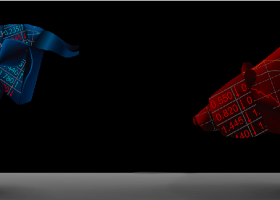EVERYTHING ABOUT SUPPORT AND RESISTANCE
introduction
Support and resistance are key concepts in technical analysis and are used by traders and investors to identify potential levels where an asset's price may experience a change in direction.
support and resistance
Support refers to a level where the price of an asset has struggled to move lower. It is a price level where demand is considered strong enough to prevent the price from declining further. The idea behind the support is that buyers enter the market and push the price back up as the price approaches this level.
On the other hand, resistance is a price level where the asset's price has had difficulty rising above. It is a level where supply is considered strong enough to prevent the price from rising higher. As the price approaches this level, sellers enter the market and push the price back down.
Traders often use support and resistance levels to determine their trading strategy. If an asset's price is approaching a support level, traders may consider buying the asset with the expectation that it will bounce back up from the support level. Conversely, if the price is approaching a resistance level, traders may consider selling the asset with the expectation that it will pull back from the resistance level.
Support and resistance levels can be found by analyzing historical price data, looking for instances where the price has bounced off a certain level multiple times. Technical indicators such as trend lines and moving averages can also be used to identify potential support and resistance levels.
It's important to note that support and resistance levels are not exact price points and the asset's price may break through these levels. In such cases, the previously established support or resistance level may become a new level of support or resistance.
Types of support and resistance
Traders and investors commonly use several types of support and resistance to identify potential price levels in technical analysis. Some of the most common types are:
Horizontal Support and Resistance: This refers to a specific price level that the asset's price has struggled to move above or below in the past. This level can be identified by connecting the high or low prices on a chart to form a horizontal line.
Trend Line Support and Resistance: This type of support and resistance is created by connecting two or more low or high prices to form a line that slopes up or down. Trend lines can act as a form of support or resistance, depending on the slope of the line.
Dynamic Support and Resistance: This refers to moving average lines that act as a form of support or resistance. For example, a 20-day moving average line can act as a level of support or resistance for the asset's price.
Round Numbers: Round numbers, such as $100 or $50, can also act as potential levels of support or resistance. This is due to the psychological impact of these numbers, which can cause traders to buy or sell an asset at these levels.
Fibonacci Retracements: These levels are based on the Fibonacci sequence and are commonly used to identify potential levels of support or resistance after a price move.
It's important to remember that these types of support and resistance are not set in stone, and the asset's price may break through these levels. In such cases, the previously established support or resistance level may become a new level of support or resistance.
pros and cons of support and resistance
Support and resistance are popular concepts in technical analysis, but they also have their advantages and disadvantages.
Pros:
1. Provide a clear entry and exit strategy: Support and resistance levels provide traders with a clear strategy for entering and exiting trades based on the price action of an asset.
2. Identify potential price changes: By identifying levels of support and resistance, traders and investors can anticipate potential price changes and make informed investment decisions.
3. Easy to use: Identifying support and resistance levels is relatively straightforward, making it accessible for traders of all levels of experience.
Cons:
1. Subjectivity: The identification of support and resistance levels is subjective and can vary from trader to trader, which can lead to conflicting opinions.
2. Not always accurate: The price of an asset may break through a support or resistance level, which can result in false signals and incorrect trading decisions.
3. Limited to historical data: Support and resistance levels are based on historical price data, which may not necessarily be a reliable indicator of future price movements.
how to use support and resistance
Here are the steps to using support and resistance:
1. Identify the levels: The first step is to identify the support and resistance levels. This can be done by analyzing historical price data, connecting lows or highs to form horizontal or trend lines, or using technical indicators such as moving averages or Fibonacci retracements.
2. Look for confirmation: It's important to wait for confirmation that the support or resistance level is holding before entering a trade. This can be done by observing the price action of the asset, such as a bounce off a support level or a rejection at a resistance level.
3. Determine entry and exit points: Once the support or resistance level has been confirmed, traders can determine their entry and exit points based on the price action of the asset. If the asset's price is approaching a support level, traders may consider buying the asset with the expectation that it will bounce back up from the support level. Conversely, if the price is approaching a resistance level, traders may consider selling the asset with the expectation that it will pull back from the resistance level.
4. Use stop losses: It's important to protect against potential losses by using stop-loss orders. A stop-loss order is a predetermined price at which the trader will exit a trade if the price moves against them.
5. Monitor the levels: Support and resistance levels are dynamic and can change over time, so it's important to monitor them regularly. Traders should look for any changes in the levels and adjust their strategy accordingly.
Conclusion
Using support and resistance levels in technical analysis can be an effective tool for traders and investors. By correctly identifying these levels and using them in conjunction with other analysis methods, traders can make informed investment decisions and potentially increase their chances of success.



